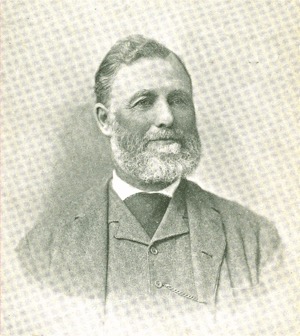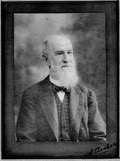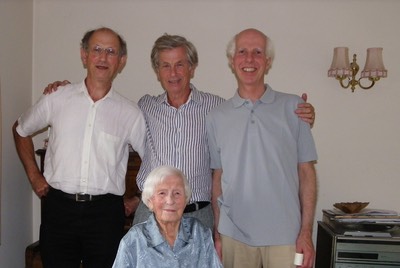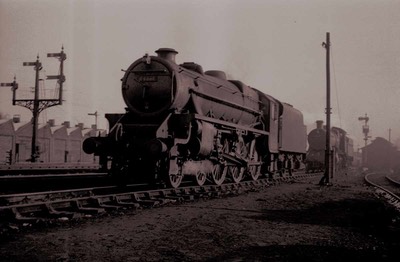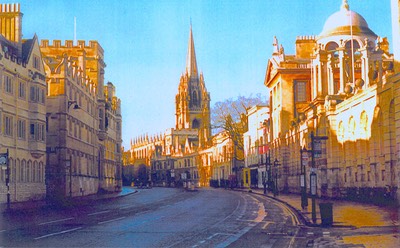At Dunlop’s Aviation Division: Frank Mortimer, an inventor in the braking-hydraulics field. I used to visit Frank at Dunlop’s Coventry Aviation Division, driving over from Erdington in our Austin A40 Farina. This is about 1966 - 1968. I enjoyed the technical subject matter of servo-assisted hydraulic systems for aircraft brakes, especially the tunes you could play on differential piston areas. Frank was in his forties then, so he must be in his nineties now. Well, well. I was working for Alan Hinton in the engineering section of Dunlop’s patents department at the Research Centre, close to Fort Dunlop. Why ‘Engineering’ after a chemistry degree? Answer: because I had done ‘Chem-Eng’ as a subsidiary subject at UMIST, and that ‘meant I was an engineer’, so Mr Mackay, Alan’s boss said!
Also at Dunlop: Hugh Lorraine Folkes and ‘Mr’ Brooke of Dunlop Belting Division at Speke, Liverpool. ‘Mr’ Folkes (I was very junior and never thought in those far off days of calling such an auspicious person anything else), was an outside inventor and hailed from the South Coast, probably Hastings, and his inventive (if it was) idea was that a converyor having portions travelling at different speeds could be achieved by having the converyor made up of oblong converyor platform elements which are arranged laterally in the slow sections and longitudinally (or more so) in the higher speed sections. I’m not aware that this project ever came to anything, though I think Dunlop pursued it quite vigorously. Mr Brooke was the manager/director of the belting division, and my main recollection of him was the splendid lunches that we sometimes had on those days out to Liverpool at the pub called ‘Fiddlers Ferry’ beside the Bridgewater Canal, eating massive helpings of nourishing stuff from oval plates! (to be completed - re Dunlop “Starglide” belting). Harry Butler was really just a name - the inventor of the ‘Dunlop Disc Brake’ which (I was told by my then-boss, Alan Hinton, chartered patent agent) had ‘won’ Le Mans in (about) 1953. Not sure about the accuracy of that recollection. Anyway, the brake was the first successful disc brake and Harry was the inventor, and Alan worked extensively with him on an application for extension of term of the patent on grounds of inadequate remuneration. Harry was retired by the time this application was made. The inventive feature was guiding the pads up to very close to the disc whereby brake-judder was avoided. They got 4 years extension (making 20 in all). A great achievement. All reported in the relevant RPC of course.
At Massey-Ferguson’s Coventry engineering centre, the combine harvester section (before it was moved to Paris), Les Kepkay, the chief combine harvester engineer. This was in the early 1970s. He already had several (if not many) patent cases in his name before I joined MF. We worked on improvements to the "MF Multi-Flow Grainsaver” (which was used on combines having ‘5’ as a suffix to the model number e.g. MF525 and 625) and which enabled the combine to go faster without letting more grain be lost at the back of the straw-walkers. Also at Maudslay Road, Bill Bailey, Chief Engineer (Implements) such as the MF30 Drill (a big seller and relatively new in 1970) and its Wheel Track Eradicator, which was the first case I drafted at MF’s patent department, on joining MF - of which more anon, and how it led to me joining Hestair in 1978. Bill Bailey was also in charge of the MF70 (I think that was the number) Top Drive Rotary Mower, which was a source of much interesting patent work as it had to be designed to avoid infringement of the then-dominant patents held by Petrus Wilhelmus Zweegers, in all relevant countries. We achieved that. I also drafted our patent case on the MF70 - it was, I believe, the first ‘top drive/bottom support’ rotary mower. (Added 1.3.16): Bill Bailey has published a most readable autobiography entitled: “You may be good at something - we don’t know what that something is yet, but what we do know is that it is not Latin”. This came from his schoolmaster at an early stage in his schooldays. A lovely chestnut. Nicely illustrating Bill’s talent for setting-off his own down-to-earth practical ability amusingly against the (sometimes) slings and arrows of the world, though he does seem to have led rather a charmed life in many ways. How interesting that he had ten years at Alvis from about 1953 to 1963, working on trouble-shooting their aero engines - this being about 25 to 35 years after Bill Dykes was racing for Alvis at Le Mans and elsewhere.
Also at MF: Jean-Claude Muller, Gilbert Delfosse, John Foster, Bill Bailey, Alex Crawford.
At MF’s European Harvesting Machinery Engineering Centre, at Le Plessis-Robinson, on the south side of Paris, which took over from Les Kepkay’s department at Maudslay Road, Coventry at some point in the middle 1970s, I used to visit Jean-Claude Muller, Gilbert (pronounced: ‘Jeel-Bear’) Delfosse, John Foster, and others whose names have slipped. John had relocated from Coventry. I used to visit from Coventry at more or less regular three-monthly intervals during about 1973 - 1978. I much enjoyed those visits. My French friends always made me very welcome and I felt a valued member of ‘the team’. Speaking French was my hobby for many years. And it clearly helped that at least the unimportant parts of our conversations were conducted in their native tongue. As indeed were my negotiations with Gebrüder Claas, the German combine harvester manufacturers, who took a licence under the MF grain-tank-leveling-auger patent, of which more anon. Jacques Loriot, one of the partners at S.A. Fedit Loriot (click here for more information), was another Frenchman who entered into this ‘Phil was a Francophile’ equation and added much to my love of these French visits, and has left me with a memorable little phrase of (I assume) idiomatic French: "(La langue Française)..C’est mon violon d’Ingres”. Gilbert Delfosse (chief combine harvester engineer) likewise has left me with a memory of something apparently trivial in the extreme, but which at the time seemed an important element of being comfortable with the French language: in an empty Auberge in the middle of nowhere (on a trip with him to see a combine at work no doubt) he summoned the waiter with: “S’il vous plait”. That’s how the French do it, I thought. He also taught me the value of having available for instant donning, a boiler-suit and wellies so that one could attend field-tests (eg at Viarmes, north of Paris) while still wearing one’s smart office-suit, and the emerge ready for ‘office action’ within one minute flat. Gilbert drove a ‘De Gaulle’-style big Citroen, and one year took it up to the North Cape of Sweden (Norway?) - an enormous drive from Paris. Just to see the sky there on the one particular night of the year when it was best. Jean-Claude Muller was just a nice guy, combine engineer, and charming Frenchman (or was he Swiss, it occurs to me? I absolutely don’t know). Anyway, it was always a delight to visit and do business with him. We worked together with great pleasure at Le Plessis, but I never knew anything else about him whatsoever. You will find him named as inventor, I feel sure, on some cases I filed in those days. John Foster I remember as a ‘typical Maudslay Road Ferguson engineer-type’ who had made the jump to France when things changed in the 1970s and appeared to have settled nicely somewhere within reach of Le Plessis Robinson, and gave me, I remember well, the benefit of his advice on French wine: “You can always rely on Côtes du Rhone”. And he’s roughly right isn’t he? John likewise was always pleasant to work with. I also remember about John, a story he told about the freshness of French meat, which somewhat horrified (and still does) my vegetarian tendencies, the punch-line of which was to the effect that in French markets, the meat hung-up for sale is so fresh that it is still twitching! And Alex Crawford was another Maudslay Road engineer that I got to know only to the limited extent that work strictly required. When I rang up ‘Engineering’ and someone sang-out "Phil Archer for ………..” (whoever I was calling), there would go up very audibly: “Dum de dum de dum de dum, dum de dah de doo dah” (“The Archers” soap opera signature tune from Radio 4 at 6.45 each evening). Typical drawing-office stuff! Alex worked on balers. He had invented before my time the MF Knotter, a very complex piece of kit which (so I understood) did a wonderful job. Alex was younger, or looked it, than some of the other engineers at Maudslay Road. I don’t think we filed any further patent applications on the knotter. He may have been involved in the MF70 Rotary Mower project. He may have been the, or one of the, inventor(s) named in our patent application on that machine. (Added 11.01.16): Another name from those days is Bill (AJ) Bailey, the chief engineer on implements at Maudslay Road, when I joined MF in January 1970. My first patent case was on the tractor wheel-track-eradicator of the MF30 seed drill, which had been designed and developed there. Thereby hung a tale, of which more later. Bill was an easy-going likeable man-in-charge, and I have recently (since Xmas 2015) been reading his entertaining autobiography, sent to me as a ‘Christmas Card’ by my former MF boss, Bryn Jones. (Just realised that Bill is already mentioned above. No matter). Bill’s book is inspiring on the things he found the time and energy to do after losing his wife at age 52. Likewise his accounts of technical problems solved, over the years, by taking a ‘stand back and look at the whole problem’ approach, which, many-a-time, enabled him to cut through and solve problems which had long-awaited solution by others. I also love the book’s title: “You may be good at something” (which continues): “…but we have yet to find out what it is. It’s certainly not Latin”. Thus his schooldays’ Latin master’s assessment of him, though, sadly, this teacher was evidently soon to be a victim of Alzheimer’s, while his pupil had moved on to a successful career as an engineer. One of Bill’s ‘on-the-way-up’ career moves was to Alvis in Coventry, then (1953-1963) having an aero-division as well as making 'The Grey Lady’ limousine (which was almost as prestigious as a Rolls Royce), and much else - a link (for me) with Bill Dykes’s Alvis motor-racing days in the late 1920s, thirty years before. Bill Bailey worked on a successful fuel-injection system for The Grey Lady. Another link with Alvis in Coventry, is that when Ruth and I moved-on from Methodism to Unitarianism (approx 1975/6), while living in Balsall Common, a village outside Coventry, the Coventry Unitarian church was located near (it was a location-assisting landmark for me) a railway bridge with (I recollect vividly) the name “Alvis” in large block-capitals extending the full-length of the bridge.
Then there was also MF’s Australian Cane Harvesting Operation at Bundaberg, where I worked with Don Quick, the new Chief Cane Harvesting Engineer, appointed during my year (1970-1978) at MF. Don was appointed in succession to the very memorably-named previous engineer, one ‘Jacek Januariusz Zagorski’, who had fought in WW2 with US troops. I drafted numerous cane harvesting cases invented by Don Quick, relating to aspects of the chopped-stick system that MF had taken-forward substantially, or pioneered. One day I must look up some of those published specs. At the time I believed I probably knew more about current chopped-stick cane harvesting technology than anyone else in the UK. Don and I got on very well. I never got round to visiting Bundberg - probably because Don and I got on so well without the need for me to do so. But I did meet Don in Florida when MF held a Cane Harvesting Meeting at xxxxx (will remember the place in due course - Yes: ‘Lake Okechobee'), and we had the opportunity to go out into the Florida cane fields and inspect the machinery in operation - which was a wonderfully enlightening experience. I have some photos from that trip which I will add in due course.
In my private practice career with UD&L, in more recent years, there are many names which stand out, including Barbara Jones of Snap-On Tools at Kings Lynn, Norfolk, and Don Huber of patent-attorneys McCormick Paulding and Huber in Hartford, Connecticut. Barbara and I worked on a whole portfolio of inventions that she originated in the field of automotive testing, using the concept of signature recognition in relation to waveform analysis, for data-extraction purposes.
